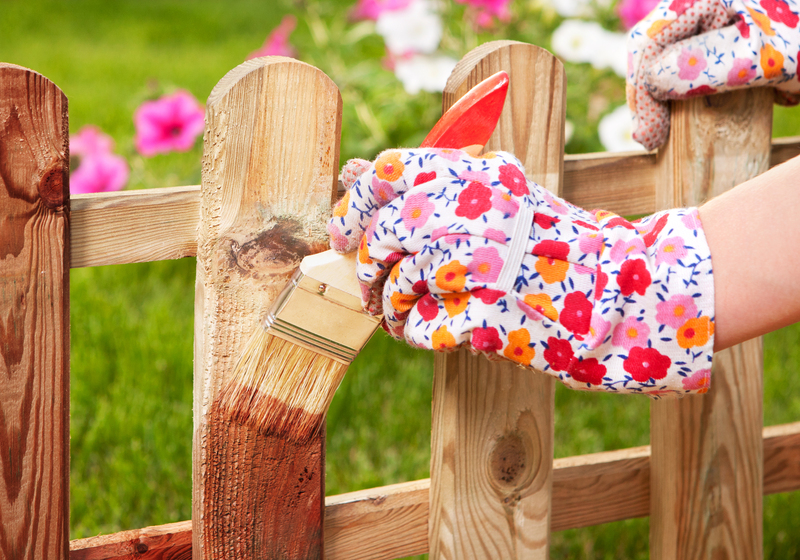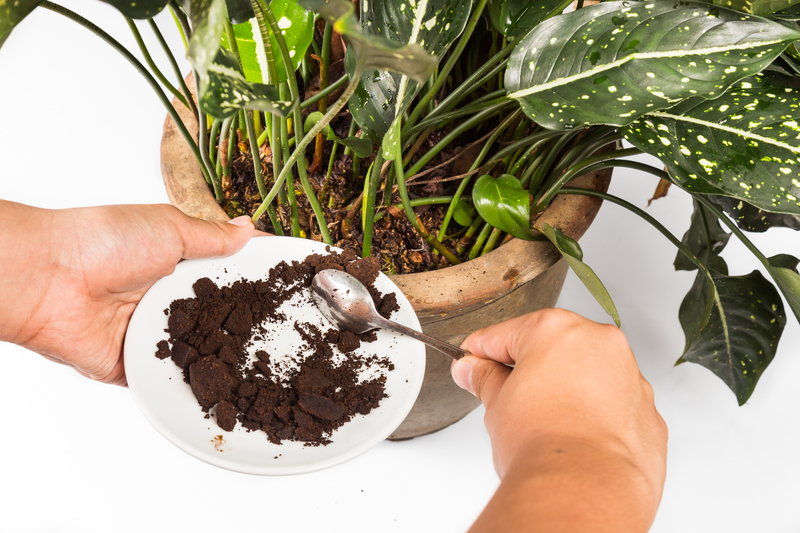Nurture a Safe and Joyful Garden Space for Kids
Posted on 03/07/2025
Nurture a Safe and Joyful Garden Space for Kids
Creating a safe and joyful garden space for kids is one of the most rewarding projects for parents, guardians, or anyone who loves to see children flourish. A garden offers endless opportunities for fun, learning, and physical activity, all within the nurturing arms of nature. But how do you transform an ordinary patch of green into an enchanting, secure, and playful sanctuary? This comprehensive guide will walk you through every step of cultivating a child-friendly garden that allows youngsters to explore, play, and grow in the safest environment possible.

Why Is a Kid-Friendly Garden Important?
We live in an era where screens often monopolize children's attention. Encouraging outdoor play in a secure garden space for children fosters healthier habits, stimulates creativity, and builds confidence through problem-solving and hands-on discovery. Let's look at a few compelling reasons to nurture a safe and delightful garden for kids:
- Promotes Physical Health -- Kids who play in gardens get natural exercise, strengthen their immune systems, and develop better coordination and motor skills.
- Supports Mental Well-being -- Interactions with plants and soil have been linked to lower stress levels and improved mood in children.
- Encourages Curiosity and Learning -- Gardens are living laboratories where youngsters can discover nature, science, and environmental stewardship in action.
- Fosters Social Interaction -- Cooperative garden games and group projects nurture teamwork and communication skills.
- Offers Safe Exploration -- A well-designed child-friendly garden ensures young ones can play and experiment without unnecessary risks.
Planning Your Child-Safe and Joyful Garden
Assessing Your Space
Before you pick up a spade, take a good look at the area you have available. Is it a backyard, a rooftop, side yard, or balcony? Each space presents unique opportunities and challenges for safe garden design for children. Measure your area and sketch a rough layout, marking sunny versus shady spots, existing trees or features, and boundaries such as fences or walls.
Setting Clear Boundaries
Safety begins with boundaries. Sturdy, childproof fencing or natural borders (like dense shrubs) should mark the perimeter, ensuring kids can't wander unsupervised. Gates should be child-safe but accessible to adults in case of emergency. If your space adjoins driveways or roads, double-check all entry points are secure.
Dividing into Zones
A well-structured garden space for kids often uses "zones" for different activities, such as:
- Active Play Area -- For running, trampolines, swings, or climbers.
- Quiet Retreat -- Cozy nooks with benches, hammocks, or reading tents.
- Growing Zones -- Raised beds or pots for edible gardening or flower-growing.
- Wildlife and Sensory Corner -- For bug hotels, bird baths, wind chimes, or sensory plants.
By integrating these zones, you encourage a mix of energetic, restful, and educational experiences within your kid-safe outdoor oasis.
Essential Elements of a Kid-Safe Garden
Choosing Child-Safe Plants
Selecting the right plants is crucial for a safe garden haven for children. Avoid toxic species such as foxglove, oleander, or certain types of mushrooms. Instead, opt for child-friendly, non-toxic plants like sunflowers, marigolds, nasturtiums, snapdragons, strawberries, and blueberries. Herbs such as mint, basil, and chives add fragrance and are safe to touch and taste.
- Pollinator-friendly Blooms -- Encourage butterflies and bees without dangerous thorns or irritating sap.
- Edible Crops -- Easy-to-grow veggies and fruits (like cherry tomatoes or sugar snap peas) inspire healthy snacking and garden engagement.
- Sensory Plants -- Lamb's ear (soft leaves), lemon balm (scented), or ornamental grasses (tactile and rustling in the wind).
- Avoidance -- Steer clear of stinging nettles, deadly nightshade, or spiky cacti.
Safe Soil and Surfaces
Soil should be clean and free of sharp debris, glass, or pollutants. Use certified organic compost to avoid chemical residues. For play surfaces, consider the following:
- Grass or Turf -- Soft, resilient, and gentle for falls.
- Mulch (e.g., bark or wood chips) -- Great for cushioning around play equipment (avoid cocoa mulch, which is toxic to pets and potentially children).
- Rubber Mats/Pavers -- Ideal for high-traffic or under swings and slides.
Avoiding Hidden Hazards
To guarantee a secure garden space for kids, complete a thorough safety audit:
- Remove or fence off water features like ponds, as they pose drowning risks.
- Secure or remove sharp-edged garden tools and store fertilizers/chemicals out of reach.
- Check play equipment for rust, splinters, or wobbly connections.
- Inspect for protruding roots, rocks, or holes that could cause trips or falls.
Fostering Joy and Creativity: Playful Garden Features
Interactive Elements
Bring your safe, playful garden space for kids to life with interactive features:
- Mini Mud Kitchens -- Simple setups with old pots, pans, and utensils inspire pretend cooking and sensory exploration.
- Kid-Sized Planting Beds -- Let children have their own plots for growing sunflowers, veggies, or fairy gardens.
- Stepping Stones or Log Paths -- Practice balance and create magical walkways.
- Natural Play Structures -- Teepees made with bamboo and bean vines, stick forts, or willow domes for imaginative hideaways.
Engaging Senses and Wildlife
A joyful garden for children should delight the senses:
- Wind Chimes and Musical Walls -- Foster auditory discovery and creativity.
- Butterfly and Bee Hotels -- Encourage observation and care for pollinators.
- Herb Spirals or Scented Walkways -- Tempt tiny noses and fingers to explore texture and aroma.
- Colorful Flowers -- Add visual excitement and attract helpful insects.
Flexible, Age-Appropriate Features
Children grow fast! Design your safe outdoor space for kids to adapt:
- Toddler Play Areas -- Soft mats, water/sand tables, and low sensory plants.
- Preschool Zones -- Mini veggie gardens, trike paths, and simple climbing frames.
- For Older Kiddos -- Larger climbing structures, tree swings, and spots for science experiments or reading clubs.
Building a Sense of Ownership and Responsibility
A joyful and safe garden space for children isn't just about playing--it's a fantastic way to foster responsibility and self-esteem. Invite your kids to help:
- Choose seeds and plan garden layouts
- Water and care for their own plants
- Participate in composting food scraps
- Design labels or garden signs
- Build bug hotels or simple habitats
By nurturing a sense of ownership, children grow more attentive to both their own safety and their impact on nature, reinforcing lifelong positive habits.
Seasonal Activities in a Child-Friendly Garden
Spring & Summer Wonders
- Plant Colorful Annuals -- Let kids dig and sow marigolds, zinnias, and sunflowers.
- Create Butterfly Puddling Stations -- Shallow water trays with stones in shady spots attract pollinators.
- Organize Garden Picnics -- Enjoy outdoor meals surrounded by blooms.
Fall Fun
- Harvest Veggies -- Dig potatoes, pick pumpkins, or try an apple-tasting challenge.
- Leaf Pile Play -- Rake and jump in leaf mounds--don't forget to compost the leftover leaves!
- Build Bug Hotels -- Prepare safe winter shelters for garden wildlife together.
Cozy Winter Ideas
- Feed the Birds -- Make homemade seed feeders with orange rinds or pinecones.
- Plan Next Year's Garden -- Dream up new planting schemes or design birdhouses for spring.
- Explore Winter Textures -- Hunt for frosty patterns on leaves, bark, and soil.
Essential Safety Tips for Your Kids' Garden Space
- Supervise Young Children -- Always keep an eye on little ones, especially if there are water features, sharp tools, or unfamiliar plants.
- Establish Clear Rules -- Teach kids what's off-limits, including boundaries, tool storage areas, and potentially hazardous plants.
- Keep the Space Tidy -- Regularly check for broken toys, dismantled equipment, or dangerous debris.
- First Aid Readiness -- Keep a basic kit nearby for minor scrapes and stings, and consider learning basic garden first aid.
- Sun Safety -- Encourage hats, sunscreen, and regular hydration, and provide shaded play spaces with canopies or umbrellas.
Creating Memories: Activities for a Joyful Garden
Scavenger Hunts and Nature Trails
Design a weekly scavenger hunt--find a pink flower, a smooth stone, something that flutters, or a spiraled leaf. Mark a nature trail with stepping stones or painted rocks.
Art and Craft in the Garden
- Paint pots and garden stones
- Create flower presses or nature mandalas
- String garlands with leaves, pine cones, and berries
Wildlife Spotting
- Make a chart of birds, bugs, or butterflies witnessed
- Join citizen science projects like counting pollinators

Frequently Asked Questions
Can I create a kid-safe garden in a small space?
Absolutely! Child-friendly gardens thrive on balconies, patios, or urban yards. Focus on raised planters, vertical gardens, sensory pots, and sand/water tables to offer interactive, safe fun even in compact areas.
What if my garden has a pond or water feature?
You must fence it securely--even shallow ponds can be dangerous for young children. Alternatively, swap water features for sandpits, or use decorative fountain bowls that can be emptied after use.
How can I involve my child in garden design?
Ask your child what colors, animals, or foods excite them! Have them help pick seeds, draw plans, or build simple structures. Their input builds anticipation and strengthens their bond with the space.
Conclusion: Growing a Safe and Joyous Garden for Kids
The benefits of a safe and joyful garden space for kids go far beyond fresh air and fun. These gardens offer a secure retreat for play, learning, and exploration--helping shape happy, curious, and resilient children ready to care for the world around them. Whether you're working with a sprawling backyard or a window box, follow these guidelines to nurture a safe, engaging, and wonder-filled outdoor sanctuary for your kids.
So roll up your sleeves, gather your little helpers, and embark on your journey of growing a magical, secure, and delightful garden space for children. The memories--and benefits--will last a lifetime.





